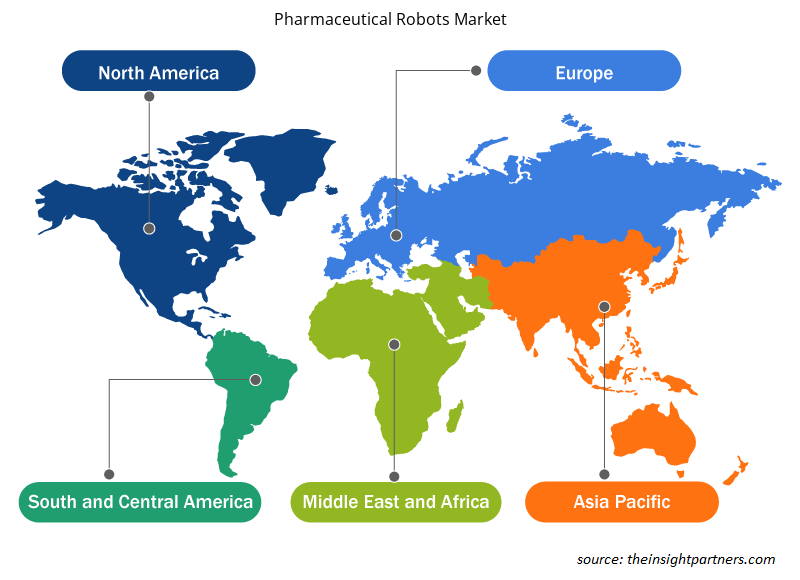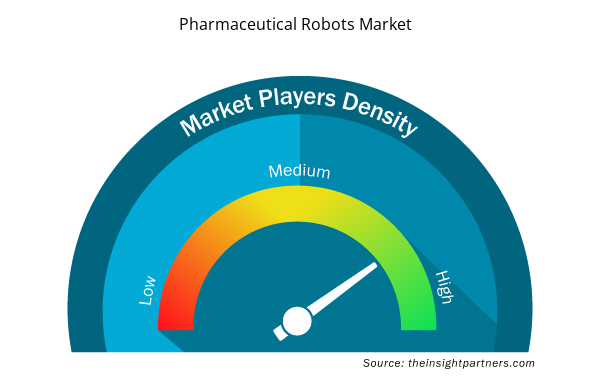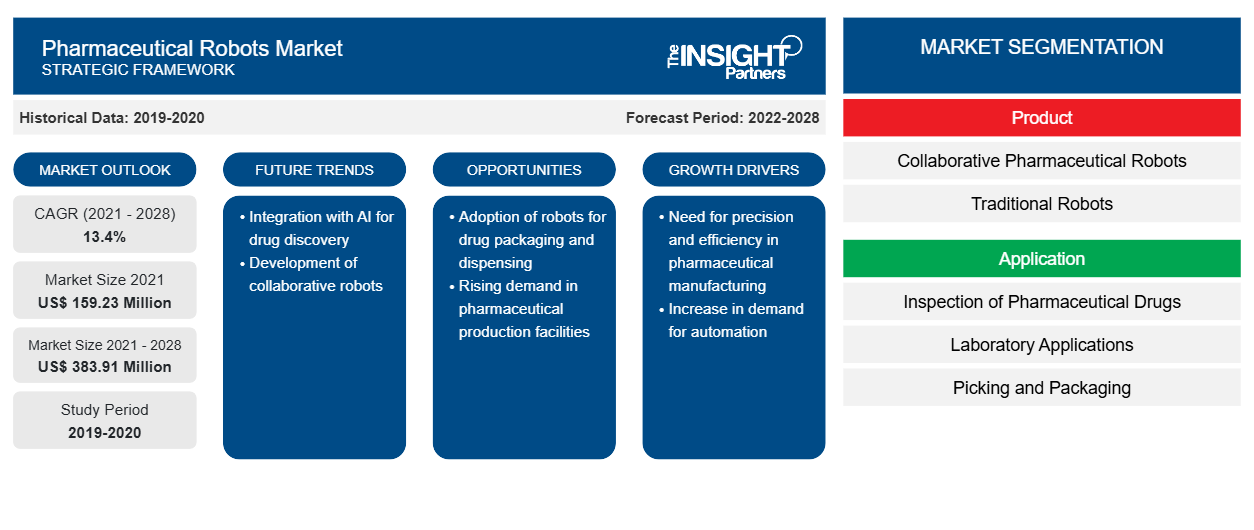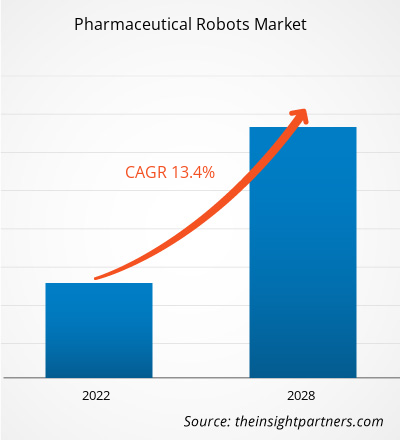[Rapporto di ricerca] Si prevede che il mercato dei robot farmaceutici raggiungerà i 383,91 milioni di dollari entro il 2028, rispetto ai 159,23 milioni di dollari del 2021; si prevede che crescerà a un CAGR del 13,4% dal 2021 al 2028.
L'industria farmaceutica richiede una precisione efficiente e precisa nella produzione di farmaci. Pertanto, l'uso di robot nella produzione farmaceutica migliora la qualità e riduce costi e tempi. I robot si stanno dimostrando vantaggiosi nel riempimento, nell'ispezione, nel confezionamento, nei laboratori e nella produzione di medicinali personalizzati. Un sistema robotico è un tipo di automazione che ha più assi di movimento e può essere programmato per svolgere qualsiasi funzione.
Il rapporto offre approfondimenti e analisi approfondite del mercato dei robot farmaceutici, sottolineando vari parametri quali tendenze di mercato, progressi tecnologici, dinamiche di mercato e analisi del panorama competitivo dei principali attori del mercato in tutto il mondo. Include anche l'impatto della pandemia di COVID-19 sul mercato in tutte le regioni. L'impatto della pandemia e la diminuzione delle attività di ricerca globali hanno anche danneggiato le operazioni e l'esecuzione finanziaria di diverse aziende nel mercato dei robot farmaceutici. L'OIE, l'Organizzazione mondiale per la salute animale, supporta la ricerca per la loro ricerca in corso e altre implicazioni del COVID-19 per la salute degli animali e la salute pubblica del pollame. L'organizzazione aiuta anche nella valutazione del rischio, nella gestione del rischio e nella comunicazione del rischio. L'OIE ha implementato un sistema di coordinamento degli incidenti per coordinare queste attività. Inoltre, la pandemia di COVID-19 e le conseguenti imposizioni di blocco hanno avuto un impatto significativo sui settori dell'allevamento e del pollame in diversi paesi del mondo. Si è scoperto che il divario tra domanda e offerta diminuisce gradualmente con l'apertura delle catene di mercato e ulteriori misure adottate dalle amministrazioni locali per colmare i colli di bottiglia nei sistemi di consegna. Si prevede inoltre che l'impatto continuerà a essere duraturo e avrà un impatto notevole sul sostentamento, l'occupazione e l'economia complessiva del settore. Il mercato dei robot farmaceutici è segmentato in base a dosaggio, malattia, tecnologia e regione. Il mercato, in base alla regione, è segmentato in Nord America, Europa, Asia Pacifico, Medio Oriente e Africa e Sud e Centro America.
Approfondimenti di mercato
Personalizza questo report in base alle tue esigenze
Riceverai la personalizzazione gratuita di qualsiasi report, comprese parti di questo report, o analisi a livello nazionale, pacchetto dati Excel, oltre a usufruire di grandi offerte e sconti per start-up e università
- Scopri le principali tendenze di mercato in questo rapporto.Questo campione GRATUITO includerà analisi di dati che spaziano dalle tendenze di mercato alle stime e alle previsioni.
Tendenza crescente della robotica cloud
La robotica cloud è un campo emergente della robotica radicato nel cloud computing, nello storage cloud e in altre tecnologie Internet incentrate sui vantaggi dell'infrastruttura convergente e dei servizi condivisi. La connessione dei robot al cloud aumenta la potenza di calcolo, lo storage e le comunicazioni. I robot cloud comunicano tra loro e quindi le operazioni vengono eseguite facilmente.
La piattaforma Google Cloud Robotics combina intelligenza artificiale, robotica e cloud per consentire l'apertura di un ecosistema di soluzioni di automazione che utilizzano robot collaborativi connessi al cloud. Insieme ai servizi di intelligenza artificiale e apprendimento automatico, i robot saranno in grado di svolgere in modo efficiente i processi in ambienti altamente dinamici nel settore manifatturiero. Inoltre, nel settore, il cloud è un alleato per l'elaborazione di una grande quantità di dati. Ad esempio, Exscientia e Celgene, un'azienda biofarmaceutica, hanno annunciato un accordo da 19,64 milioni di euro nel 2019 per accelerare la scoperta di farmaci per il cancro e le malattie autoimmuni. Nel 2020, ha anche annunciato una collaborazione con altre aziende per trovare possibili farmaci per il COVID-19. Di conseguenza, l'azienda ha ora accesso a un pacchetto di molecole, inclusi farmaci e altre sostanze chimiche, che sono state testate con successo sugli esseri umani. L'azienda intendeva esaminare l'elenco per eventuali farmaci in grado di combattere il virus. La tecnologia di Exscientia analizza i grandi database e può prevedere con precisione quali composti non generano effetti collaterali per raggiungere l'obiettivo desiderato. Analogamente, nel 2020, un'altra azienda farmaceutica, Boehringer Ingelheim, ha stretto una partnership con un'azienda biotecnologica, Click Therapeutics, per produrre 500 milioni di dollari in trattamenti digitali. Più precisamente, entrambe le aziende hanno pianificato di collaborare allo sviluppo e alla distribuzione di un'applicazione mobile per aiutare i pazienti schizofrenici con deficit cognitivi. Inoltre, IBM ha creato RoboRXN, un laboratorio chimico che utilizza intelligenza artificiale, cloud computing e robotica per sviluppare farmaci dalle case dei ricercatori.
Il software basato su cloud, con protocolli di sicurezza appropriati, può essere adottato per facilitare l'integrazione e l'automazione. Il suo utilizzo aiuta a ridurre la burocrazia delle aziende, rendendo i dati gestibili. Pertanto, si prevede che la robotica cloud diventerà la tendenza nel mercato dei robot farmaceutici in futuro.
Approfondimenti basati sui prodotti
In base al prodotto, il mercato dei robot farmaceutici è segmentato in robot farmaceutici collaborativi e robot tradizionali. Nel 2021, si stima che il segmento dei robot farmaceutici collaborativi rappresenti la quota di mercato maggiore, mentre si prevede che i robot tradizionali registreranno il CAGR più elevato nel mercato durante il periodo di previsione. La crescita di questo segmento è attribuita all'aumento dell'uso di robot nella distribuzione, nello smistamento, nell'assemblaggio di kit e nella manutenzione di macchine leggere, nonché in applicazioni più tradizionali associate al confezionamento e ad altri.
Approfondimenti basati sulle applicazioni
In base all'applicazione, il mercato dei robot farmaceutici è segmentato in ispezione di farmaci, applicazioni di laboratorio e prelievo e confezionamento. Il segmento dell'ispezione di farmaci deterrebbe la quota maggiore del mercato nel 2021 e si stima che registrerà il CAGR più elevato nel mercato durante il periodo di previsione.
Approfondimenti basati sull'utente finale
In base all'utente finale, il mercato dei robot farmaceutici è segmentato in aziende farmaceutiche, laboratori di ricerca e organizzazioni di ricerca a contratto. Il segmento delle aziende farmaceutiche deterrebbe la quota maggiore del mercato nel 2021, mentre si stima che il segmento dei laboratori di ricerca registrerà il CAGR più elevato nel mercato durante il periodo di previsione
Gli operatori del mercato dei robot farmaceutici adottano strategie organiche, come il lancio e l'espansione dei prodotti, per espandere la propria presenza e il proprio portafoglio prodotti in tutto il mondo e per soddisfare la crescente domanda.
Approfondimenti regionali sul mercato dei robot farmaceutici
Le tendenze regionali e i fattori che influenzano il Pharmaceutical Robots Market durante il periodo di previsione sono stati ampiamente spiegati dagli analisti di Insight Partners. Questa sezione discute anche i segmenti e la geografia del Pharmaceutical Robots Market in Nord America, Europa, Asia Pacifico, Medio Oriente e Africa e Sud e Centro America.

- Ottieni i dati specifici regionali per il mercato dei robot farmaceutici
Ambito del rapporto di mercato sui robot farmaceutici
| Attributo del report | Dettagli |
|---|---|
| Dimensioni del mercato nel 2021 | 159,23 milioni di dollari USA |
| Dimensioni del mercato entro il 2028 | 383,91 milioni di dollari USA |
| CAGR globale (2021 - 2028) | 13,4% |
| Dati storici | 2019-2020 |
| Periodo di previsione | 2022-2028 |
| Segmenti coperti | Per Prodotto
|
| Regioni e Paesi coperti | America del Nord
|
| Leader di mercato e profili aziendali chiave |
|
Densità dei player del mercato dei robot farmaceutici: comprendere il suo impatto sulle dinamiche aziendali
Il mercato dei robot farmaceutici sta crescendo rapidamente, spinto dalla crescente domanda degli utenti finali dovuta a fattori quali l'evoluzione delle preferenze dei consumatori, i progressi tecnologici e una maggiore consapevolezza dei benefici del prodotto. Con l'aumento della domanda, le aziende stanno ampliando le loro offerte, innovando per soddisfare le esigenze dei consumatori e capitalizzando sulle tendenze emergenti, il che alimenta ulteriormente la crescita del mercato.
La densità degli operatori di mercato si riferisce alla distribuzione di aziende o società che operano in un particolare mercato o settore. Indica quanti concorrenti (operatori di mercato) sono presenti in un dato spazio di mercato in relazione alle sue dimensioni o al valore di mercato totale.
Le principali aziende che operano nel mercato dei robot farmaceutici sono:
- ABB Ltd.
- Azienda
- Società elettrica Yaskawa
- Azienda: Robot Universali
- Marchesini Group SpA
Disclaimer : le aziende elencate sopra non sono classificate secondo un ordine particolare.

- Ottieni una panoramica dei principali attori del mercato dei robot farmaceutici
Per Prodotto
- Robot farmaceutici collaborativi
- Robot tradizionali
- Robot Delta
- Robot articolati
- Robot cartesiani
- Robot SCARA
- Altri
Per applicazione
- Ispezione dei farmaci
- Applicazioni di laboratorio
- Raccolta e confezionamento
Per utente finale
- Aziende farmaceutiche
- Laboratori di ricerca
- Organizzazioni di ricerca a contratto
Di
Geografia
America del Nord
- NOI
- Canada
- Messico
Europa
- Francia
- Germania
- Italia
- Regno Unito
- Spagna
- Resto d'Europa
Asia Pacifico (APAC)
- Cina
- India
- Corea del Sud
- Giappone
- Australia
- Resto dell'APAC
Medio Oriente e Africa (MEA)
- Sudafrica
- Arabia Saudita
- Emirati Arabi Uniti
- Resto del MEA
America del Sud e Centro (SCAM)
- Brasile
- Argentina
- Resto della TRUFFA
Profili aziendali
- ABB Ltd.
- Azienda
- Società elettrica Yaskawa
- Azienda: Robot Universali
- Marchesini Group SpA
- Società Denso
- Società Fanuc
- Società a responsabilità limitata Espon India Pvt. Ltd.
- Società di Shibuya
- Weiss GmbH
- Analisi storica (2 anni), anno base, previsione (7 anni) con CAGR
- Analisi PEST e SWOT
- Valore/volume delle dimensioni del mercato - Globale, regionale, nazionale
- Industria e panorama competitivo
- Set di dati Excel


- Advanced Planning and Scheduling Software Market
- Underwater Connector Market
- Electronic Shelf Label Market
- Microplate Reader Market
- Microcatheters Market
- Electronic Toll Collection System Market
- GNSS Chip Market
- Hydrogen Storage Alloys Market
- Equipment Rental Software Market
- Terahertz Technology Market

Report Coverage
Revenue forecast, Company Analysis, Industry landscape, Growth factors, and Trends

Segment Covered
This text is related
to segments covered.

Regional Scope
North America, Europe, Asia Pacific, Middle East & Africa, South & Central America

Country Scope
This text is related
to country scope.
Domande frequenti
The growth of the market is attributed to benefits offered by robots in pharmaceutical manufacturing, growing awareness of robotic systems in manufacturing process, increasing investments in pharmaceutical research and development. However, the high cost of robots and dearth of skilled professional hinder the market growth.
The types of pharmaceutical robots are collaborative pharmaceutical robots, and traditional robots. The traditional robots are segmented into delta robots, articulated robots, cartesian robots, scara robots, and others.
Pharmaceutical industry requires efficient and precise precision in production of pharmaceutical drugs. Thus, using robots in pharmaceutical manufacturing improves quality and reduces cost and time. Robots are proving advantageous in filling, inspection, packaging, laboratories, and the manufacture of personalized medicine. A robotic system is a type of automation that has multiple axes of motion and can be programmed to perform any function.Pharmaceutical industry requires efficient and precise precision in production of pharmaceutical drugs. Thus, using robots in pharmaceutical manufacturing improves quality and reduces cost and time. Robots are proving advantageous in filling, inspection, packaging, laboratories, and the manufacture of personalized medicine. A robotic system is a type of automation that has multiple axes of motion and can be programmed to perform any function.
Trends and growth analysis reports related to Life Sciences : READ MORE..
The List of Companies - Pharmaceutical Robots Market
- ABB Ltd.
- Kawasaki Heavy Industries, Ltd.
- Yaskawa Electric Corporation
- Universal Robots A/S
- Marchesini Group S.p.A
- Denso Corporation
- Fanuc Corporation
- Espon India Pvt. Ltd.
- Shibuya Corporation
- Weiss GmbH
The Insight Partners performs research in 4 major stages: Data Collection & Secondary Research, Primary Research, Data Analysis and Data Triangulation & Final Review.
- Data Collection and Secondary Research:
As a market research and consulting firm operating from a decade, we have published and advised several client across the globe. First step for any study will start with an assessment of currently available data and insights from existing reports. Further, historical and current market information is collected from Investor Presentations, Annual Reports, SEC Filings, etc., and other information related to company’s performance and market positioning are gathered from Paid Databases (Factiva, Hoovers, and Reuters) and various other publications available in public domain.
Several associations trade associates, technical forums, institutes, societies and organization are accessed to gain technical as well as market related insights through their publications such as research papers, blogs and press releases related to the studies are referred to get cues about the market. Further, white papers, journals, magazines, and other news articles published in last 3 years are scrutinized and analyzed to understand the current market trends.
- Primary Research:
The primarily interview analysis comprise of data obtained from industry participants interview and answers to survey questions gathered by in-house primary team.
For primary research, interviews are conducted with industry experts/CEOs/Marketing Managers/VPs/Subject Matter Experts from both demand and supply side to get a 360-degree view of the market. The primary team conducts several interviews based on the complexity of the markets to understand the various market trends and dynamics which makes research more credible and precise.
A typical research interview fulfils the following functions:
- Provides first-hand information on the market size, market trends, growth trends, competitive landscape, and outlook
- Validates and strengthens in-house secondary research findings
- Develops the analysis team’s expertise and market understanding
Primary research involves email interactions and telephone interviews for each market, category, segment, and sub-segment across geographies. The participants who typically take part in such a process include, but are not limited to:
- Industry participants: VPs, business development managers, market intelligence managers and national sales managers
- Outside experts: Valuation experts, research analysts and key opinion leaders specializing in the electronics and semiconductor industry.
Below is the breakup of our primary respondents by company, designation, and region:

Once we receive the confirmation from primary research sources or primary respondents, we finalize the base year market estimation and forecast the data as per the macroeconomic and microeconomic factors assessed during data collection.
- Data Analysis:
Once data is validated through both secondary as well as primary respondents, we finalize the market estimations by hypothesis formulation and factor analysis at regional and country level.
- Macro-Economic Factor Analysis:
We analyse macroeconomic indicators such the gross domestic product (GDP), increase in the demand for goods and services across industries, technological advancement, regional economic growth, governmental policies, the influence of COVID-19, PEST analysis, and other aspects. This analysis aids in setting benchmarks for various nations/regions and approximating market splits. Additionally, the general trend of the aforementioned components aid in determining the market's development possibilities.
- Country Level Data:
Various factors that are especially aligned to the country are taken into account to determine the market size for a certain area and country, including the presence of vendors, such as headquarters and offices, the country's GDP, demand patterns, and industry growth. To comprehend the market dynamics for the nation, a number of growth variables, inhibitors, application areas, and current market trends are researched. The aforementioned elements aid in determining the country's overall market's growth potential.
- Company Profile:
The “Table of Contents” is formulated by listing and analyzing more than 25 - 30 companies operating in the market ecosystem across geographies. However, we profile only 10 companies as a standard practice in our syndicate reports. These 10 companies comprise leading, emerging, and regional players. Nonetheless, our analysis is not restricted to the 10 listed companies, we also analyze other companies present in the market to develop a holistic view and understand the prevailing trends. The “Company Profiles” section in the report covers key facts, business description, products & services, financial information, SWOT analysis, and key developments. The financial information presented is extracted from the annual reports and official documents of the publicly listed companies. Upon collecting the information for the sections of respective companies, we verify them via various primary sources and then compile the data in respective company profiles. The company level information helps us in deriving the base number as well as in forecasting the market size.
- Developing Base Number:
Aggregation of sales statistics (2020-2022) and macro-economic factor, and other secondary and primary research insights are utilized to arrive at base number and related market shares for 2022. The data gaps are identified in this step and relevant market data is analyzed, collected from paid primary interviews or databases. On finalizing the base year market size, forecasts are developed on the basis of macro-economic, industry and market growth factors and company level analysis.
- Data Triangulation and Final Review:
The market findings and base year market size calculations are validated from supply as well as demand side. Demand side validations are based on macro-economic factor analysis and benchmarks for respective regions and countries. In case of supply side validations, revenues of major companies are estimated (in case not available) based on industry benchmark, approximate number of employees, product portfolio, and primary interviews revenues are gathered. Further revenue from target product/service segment is assessed to avoid overshooting of market statistics. In case of heavy deviations between supply and demand side values, all thes steps are repeated to achieve synchronization.
We follow an iterative model, wherein we share our research findings with Subject Matter Experts (SME’s) and Key Opinion Leaders (KOLs) until consensus view of the market is not formulated – this model negates any drastic deviation in the opinions of experts. Only validated and universally acceptable research findings are quoted in our reports.
We have important check points that we use to validate our research findings – which we call – data triangulation, where we validate the information, we generate from secondary sources with primary interviews and then we re-validate with our internal data bases and Subject matter experts. This comprehensive model enables us to deliver high quality, reliable data in shortest possible time.


 Ottieni un campione gratuito per questo repot
Ottieni un campione gratuito per questo repot